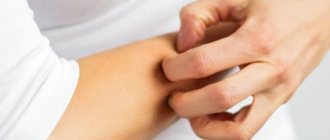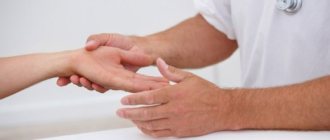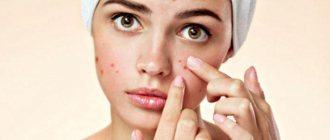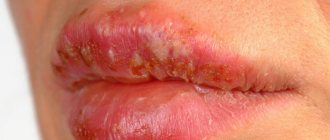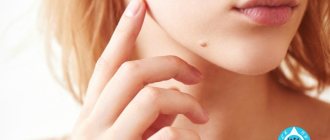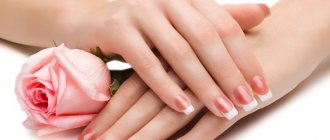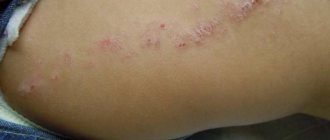When an adult or child has itchy acne on their body, it brings a lot of discomfort into a person’s life. Especially when they also itch. Their appearance can be triggered by several factors, including: unsuitable climatic conditions, nervous stress, and even poor-quality food.
In this article we will tell you why acne itches and what factors exist that contribute to its occurrence.
Etiology of itching
Itching is a skin reaction of varying severity in the form of irritation or burning, which occurs in a certain area of the skin and causes a desire to eliminate it. There may be no visible manifestations or there may be slight redness of the upper layer of skin, which will itch. Itching is always a consequence of exposure to parasites, chemicals, and bacteria. If the etiology is unclear, you can try simple remedies such as antibacterial cream and cold water. But if the process continues to worsen and the whole body itches, you should immediately consult a doctor.
Itchy skin can be localized or generalized, in which irritation is observed in different places. Having carefully examined the affected areas in the first case, most often you can find insects (lice, scabies bug, mosquito, flea), or atopic skin dermatitis, the etiology of which cannot be determined. In such cases, doctors recommend using folk remedies such as baking soda, hydrogen peroxide or table salt. Insect bites can be easily identified by the fact that characteristic marks left by their activity appear on the body, in the form of a small swelling with a dot in the middle, a bump with a tip, or a two-color, red and white spot.
The cause of itching may be failure to comply with sanitary and hygienic standards (stale underwear or bed linen), musty air in the room, dust that has not been removed for a long time, the use of household chemicals or chemicals during cleaning, heat or cold, and other objective reasons for which the skin react with specific irritation. But everything may not be so harmless if a negative phenomenon is observed throughout the body, and in order to relieve it, you have to resort to medications. Generalized itching may be a consequence of systemic disorders of the internal organs and indicate malfunctions of the endocrine system. The skin does not itch for no particular reason and needs to be taken care of.
Treatment of infected skin
Infected skin appears inflamed, with large pustules present that hurt when touched. Most often, acne occurs on the forehead. If pimples itch, itch and hurt, in this case the patient must consult a doctor.
Extensive inflammation of the facial skin can lead to the formation of large pustules and cysts filled with pus. When such formations rupture, large wounds appear that heal over time. In their place, rough scars and cicatrices appear, which are almost impossible to get rid of.
To treat this form of the disease, the patient must use ointments with antibacterial components in the composition. Treatment is often supplemented with antibiotic tablets. In this case, only a doctor can select medications. You should not take antibiotics on your own, as this may worsen the situation due to the wrong choice of medications.
At home, the only thing the patient can do is to provide protection against further spread of infection and thereby avoid the appearance of new acne. To do this, it is necessary to treat the skin with antiseptic solutions and ointments.
Even if you really want to scratch the inflamed skin, you absolutely cannot do this, so as not to spread the infection to healthy areas of the skin.
Signal of serious illness
Red pimples on the body that accompany itching may be the result of diseases and disorders. The first thing a dermatologist suggests is an allergy. Allergic reactions in all their diversity have become a real disaster of the modern era. If red pimples on the body itch, there are 3 main options:
All other numerous causes are only a consequence of the types that the main cause takes. An infectious disease can be measles, rubella, chickenpox, which an adult did not have in childhood in a mild form, at the initial stage, because as the infection progresses, the symptoms will become threatening. In case of parasitic infection, such rashes are caused by demodicosis (more precisely, its causative agent is the eyelash mite), some types of helminths (with a serious concentration of parasites inside the body), and scabies mite. Mycoses (fungal infections of the skin or genital organs) also cause itching, but their external manifestations are not in the form of small pimples. Viral herpes, accompanied by characteristic manifestations, may be in the form of blisters, but not in the form of a scattering of small pimples.
Allergic reactions occupy the largest place in this list of causes. Dermatitis, contact dermatitis, urticaria, eczema, allergic rashes to low-quality, inappropriate or consumed in excess products, allergic reaction of the nervous system to stress and emotional overload, eczema in the initial stage - all this at the beginning of the process fits the definition of small pimples on the body itchy. Sometimes it is difficult for an allergist to identify the real cause that caused a negative phenomenon; often it cannot be found in external stimuli. But they itch no less, and may well be the cause of internal metabolic disorders, disruption of the endocrine system, and pathology of the digestive system. Without laboratory tests, only one thing can be said with certainty: if the rash appears and itches, you will have to go to the doctor.
Why do acne appear?
This happens because the hair follicles are connected to the sebaceous glands. They produce a substance called sebum, which is responsible for lubricating the skin and hair, moving along the latter, opening the hair follicles, and then coming to the surface of the skin.
For various reasons, the body sometimes produces excess of this oil. If this happens and there is too much dead skin on the body, then this mixture will clog the pores. Once this blockage is formed, bacteria can enter and multiply, causing redness and inflammation. As a result, pimples appear on the skin, which are sometimes very itchy.
Most often, acne appears due to excess subcutaneous sebum.
So, what are the causes of excess sebum production? It's all due to hormones. They are the ones who rage when a person enters adolescence. Women may experience hormonal changes as they get older, especially during pregnancy, menopause, or while taking oral contraceptives.
The dangers of no treatment
Thinking that small pimples on the body itch are quite harmless and will go away if you apply ointment or cream, it seems quite reasonable if this has happened more than once and went away with virtually no treatment. But if the skin is subjected to such attacks not sporadically, but with visible frequency, it’s time to think about some measures. One day, the rash will not go away after another attack, and it will not be possible to repel it with the help of a cream, and instead of it other, more serious phenomena will appear (we are not talking about insect bites, which can be killed). If the rash is a consequence of a serious disease that has just begun to appear (and the accompanying itching throughout the body indicates this), then instead of it the following may appear:
Many diseases that could be hypothetical provocateurs for the appearance of red rashes can lead to a complex variety of skin lesions. But even if they are not there, then an untreated rash, scratched by nails that are not always clean, or rubbed by clothes, when infection gets into the pimples, can fester and cause the whole range of demonstrated stages.
Acne itches on the face
Let's start with the face. In this area, there are not many possible factors that could trigger the appearance of itchy rashes. If it is a disease, then most likely it is an infectious one. For example, in the case of chickenpox (ordinary chickenpox), the first acne may appear on the face, although this happens extremely rarely. Most often, the reason that acne on the face itches is that ordinary acne has begun to ripen more actively or gradually dry out. There's nothing to worry about. There may be several reasons for the latter. Namely:
- Have you recently applied any product to your facial skin that dries out acne;
- use of cosmetics that provoke the ripening or appearance of acne (for example, low-quality foundations);
- washing with ordinary soap, which dries the skin very much;
- using a new facial product (acne ointment, cosmetics, skincare product) that caused an allergic reaction.
Sometimes the reason that acne on the skin itches is that the face is simply very dry. This may also be indicated by the appearance of slight peeling and dry areas, with slight redness. This problem can easily be solved by using a good moisturizer and stopping the use of the products that caused this dryness.
What to do? First, analyze why the itching appeared. Some new remedy? Soap? Fatty foods that cause acne to ripen? After you answer this question, you should eliminate this product from use. Ideally, any facial skin product should be tested in a different area beforehand to prevent an allergic reaction in the most visible area of the body. If the problem is dry skin, start using a moisturizer. This is a must even for those with oily skin.
Probable Causes
In dermatology, rashes accompanied by itching are symptoms of several dozen diseases. The diagnosis is made not according to a sign that is so neutral for a dermatologist, but according to an external examination, accompanying external manifestations, and laboratory test data. Differential diagnosis takes the doctor almost more time than a preliminary diagnosis. This is necessary in order to choose the right treatment tactics. Pimples that itch may be a simple reaction to an external irritant, or may indicate the following diseases:
Itching with rashes can be of a psychogenic type: it appears when there is a fear of getting sick and a nervous disorder, then it is very difficult to identify the cause - the provocateur. Neuropathic itching throughout the body - with vascular thrombosis or neuropathy, can be caused by cholestasis and even some types of gastritis. And the more fears arise at the thought of what it could be, and why it would be so itchy, the stronger the itching develops, the more intense the desire to stop it, the more irritated skin surfaces are scratched. Damage to the skin layer that appears in torn areas can be mistaken for any manifestation of the disease, be it pimples or pimples. Even a qualified dermatologist will not immediately tell you what pimples are and why they itch.
Bumps on the skin
Lumps can appear on different parts of the skin: face, legs, arms, all over the skin and have various causes. Children, men and women are susceptible to this. Often they are practically invisible on the epidermis, but cause a lot of inconvenience: they itch and itch.
The cause is often a metabolic disorder in the body, poor quality nutrition, lack of vitamins, and non-compliance with hygiene rules. Infections and subcutaneous mites can also provoke the appearance of pimples and pimples. Let's look at some of the reasons why bumps (pimples) appear on the skin.
Keratosis follicularis
In most cases, simple bumps can be the first stage of keratosis pilaris (goose bumps), the second stage is the appearance of blood around the hair follicles, resulting in red dots appearing on top of the bumps. This is an elementary lack of vitamins C, D, A and as a result, the so-called goose bumps appear.
With this disease, excessively rapid skin renewal occurs. Dead particles of the epidermis do not have time to exfoliate and accumulate near the hair follicle, forming a dense seal, blocking the germination of new hairs, which curl up and form nodules.
The disease may begin in early childhood, but goes away over time. The primary symptom is dry skin, especially on the feet and palms. As the disease develops, skin lesions can be localized in certain areas: mostly on the arms from the elbow to the forearm, buttocks, thighs, or throughout the body.
It has not yet been possible to establish the cause of the disease. It is believed that heredity contributes to this. Since close relatives are most often affected by goose bumps. Provoking factors may include:
- Winter season. At this time, an exacerbation of follicular keratosis occurs. In summer, the skin becomes clearer.
- Taking hormonal drugs.
- Lack of vitamins C, D, A in the body.
- Strict diets, unbalanced nutrition.
- Stress that provokes disorders in the body, including the skin.
Other diseases have similar symptoms, in particular, keratoderma and Darier's disease.
Follicular keratosis is a cosmetic skin disease, since it does not bring any special problems to a person, apart from its unaesthetic appearance.
Wen
A rash of small pimples on the skin of the face and body often turns out to be wen, which in medicine is called “Lipoma” - a benign formation that does not cause harm to a person, except for cosmetic discomfort. Wen look like white pimples on the face. You cannot crush them yourself, as there is a risk of infection. And after this, the wen will again quickly fill with subcutaneous fat.
Today, there are many methods for removing lipomas, which are performed by dermatologists or surgeons. You can reduce the size of the wen using special creams.
Milia
Often a small cyst, called a milia, appears under the skin. As a result, small bumps form on the skin, which are located singly or in groups. Only a doctor can remove them, since squeezing will not lead to results.
When removing, a procedure called “Dermabrasion” is prescribed. In other words, the surface layer of the skin is polished. The operation carried out brings the patient a certain amount of pain that can be tolerated. After sanding, red spots remain on the skin, which disappear after a few days.
Hyperplasia of the sebaceous glands
On fairly oily skin, small bumps appear. This occurs due to the growth of sebaceous glands. They differ from simple wen in their flesh color, plastic state and small hole on top. With hyperplasia, the skin takes on a lumpy appearance and becomes a little dense. No inflammation of the epidermis is observed. They are removed with liquid nitrogen or cauterized with an electric current.
Subcutaneous comedones
A comedon looks like a clogged sebaceous plug that forms on the skin and looks like a flesh-colored tubercle. Groups of comedones are located not only on oily areas of the skin, but also on the temples, cheeks, and cheekbones. If you do not clean the skin for a long time, suppuration may appear and the bumps turn into reddish pimples.
Their appearance is due to insufficient cleansing of the skin. You can cleanse your face of subcutaneous comedones using scrubs and face wash foams. Noticeable results are achieved by special facial cleansing procedures in beauty salons.
Demodex skin infection
Lumpy skin may indicate that demodex, a subcutaneous mite that lives in or near the hair follicles, has settled underneath it. A sign of infection is severe itching, especially at night. Skin scraping will help confirm its presence. The bumps formed due to the presence of the mite are reddish in color, and the skin around the head of the pimple is inflamed. Treatment is carried out with antiparasitic drugs.
Molluscum contagiosum infection
If white, rather convex tubercles appear on the skin and no pain is felt when pressing on them, then infection with molluscum contagiosum can be assumed. This is a contagious infectious disease transmitted sexually or through the use of shared things. Children can become infected with it in a childcare center or school, adults - in a sauna, swimming pool or when using shared things: towels, combs, bed linen, dishes, and so on.
The disease is transmitted by the molluscum contagiosum virus. Special tests will help determine its presence, the direction for which will be given by a dermatologist.
Montgomery tubercles
Often white bumps appear on women's breasts near the nipple. Their medical name is Montgomery tubercles. Pimples are glands that surround the nipples. They become especially noticeable during pregnancy and breastfeeding. Pimples are modified sebaceous glands, on top of which there are excretory ducts of the gland that secrete a substance called “Secret”. Its purpose is still unclear.
According to unverified assumptions, it acts as a lubricant that protects the nipple from drying out. According to another version, the secreted secretion has bactericidal properties. Another version suggests that the number of pimples provides a sufficient amount of milk and has a certain smell that the baby picks up with the olfactory receptors during feeding.
The number of tubercles around the nipple indicates the presence of milk in the mother; the more there are, the more milk. The maximum number of them can be 14. After the lactation period ends, the tubercles disappear. They appear in the first trimester of pregnancy. Any woman needs to remember that the appearance of Montgomery tubercles is normal.
Under no circumstances should they be squeezed out. When the pimples become inflamed, they acquire a reddish tint. It is necessary to treat them with chamomile infusion, if this does not help, consult a doctor - mammologist.
Pimples on the elbow
There can be many reasons for the appearance of acne or rashes on the elbows - an allergic reaction, malfunction of internal organs. To accurately determine the cause of their appearance, you need to consult a dermatologist. Elbows are subject to constant friction, so the causes of acne can also be mechanical.
The skin on the elbows is dry and compacted, so constant care is needed, otherwise, for quite prosaic reasons, acne appears caused by infection. To avoid this, you need to constantly moisturize the skin of your elbows. Nourishing moisturizing creams are suitable for this.
Itchy bumps and pimples
When itchy pimples or bumps appear on the skin, this is a reason to visit a dermatologist. Since this can be caused by serious reasons, these include:
- Dry and weeping eczema.
- Allergic dermatitis.
- Acne (furunculosis).
- Viral infections, including chickenpox.
- Rubella.
- Prickly heat.
Eczema
The causes of eczema are poorly understood. These could be hormonal imbalances, stressful situations, lack of vitamins and microelements, poor quality nutrition. Clinical signs of eczema:
- The appearance of inflammatory bumps on the skin, turning into blisters.
- Typical places for rash: face, arms, back.
- Constant itching rash.
- The appearance of scratching.
For an experienced dermatologist, diagnosing the disease is not difficult. The treatment includes antihistamines, multivitamins, sodium thiosulfate. Be sure to use sedatives and decoctions of medicinal herbs (motherwort, valerian root, hawthorn). Hormonal and antibacterial ointments are suitable for local treatment.
Allergic dermatitis
A skin reaction to an allergen appears from exposure to pollen, certain foods, pet hair, synthetic clothing, household chemicals, and so on. Characteristic signs of allergic dermatitis are a rash on the skin of pimples, small blisters, spots that constantly itch and itch, and a rash appears.
They have no tendency to connect or grow. They are small in size and usually appear on the face and hands. The main direction of treatment is to identify the allergen and stop its effect on the body. The use of antihistamines is the main condition for effective treatment. Further therapy consists of taking antiallergic medications.
Acne (furunculosis)
A typical reaction to hormonal imbalance at a young age is the appearance of acne on the skin. Treatment must be taken seriously, otherwise rashes will appear in new places. A characteristic symptom is the appearance of reddish rashes on the skin of the face, back and chest. The shape of the rash can be different, but in most cases it is reddish pimples and papules that itch, then when scratched, suppuration appears.
The disease is easily diagnosed and treatment is prescribed, which includes local treatment with antiseptic drugs and internal treatment - antihistamines and multivitamins are taken.
There are various reasons for the appearance of pimples on the skin. Accordingly, the methods of elimination are different. These could be banal wen, allergic reactions, infection with parasites, etc. The main thing is to consult a doctor in time and determine the cause of their appearance, so that the prescribed treatment is effective.
Source: derms.ru
Hormonal disorders
In adolescence, a rash appears under the influence of hormonal imbalances. There are not so few rashes; they are localized mainly on the face, neck and chest area. Dense acne on the body does not cause discomfort. The bluish-red hue of the rash attracts attention. However, apart from being aesthetically unattractive, the rashes do not pose any danger. Read more about acne treatment →
The rash can also appear in women, depending on the phase of the menstrual cycle and the general condition of the body. If there are rashes caused by hormonal imbalances, no special treatment is required. It is enough to normalize your diet and monitor the skincare products you use. If painful and profuse rashes appear, and this process is systematic, it is advisable to check the level of hormones.
There are many provoking factors that cause the development of formations. If one pimple pops up, and a similar phenomenon occurs periodically, there should be no reason to worry. If itchy blisters form, accompanied by pain and burning, it is advisable to visit a doctor.
The greatest concern is a rash on the body in the form of tubercles and pimples, which itch and itch, causing discomfort. Such symptoms cannot be ignored, since they often signal some kind of malfunction in the body. These can be both minor disorders and serious diseases that require timely and competent treatment.
Parasitic diseases: scabies and demodicosis
There are a number of diseases, the symptoms of which are red pimples, which are classified as parasitic. These are demodicosis and scabies . Their pathogens are ticks
The first symptoms of scabies are observed immediately after the larva hits the skin. The scabies rash is localized between the toes and hands, on the stomach, chest, limbs and butt.
The main signs of this disease are a feeling of severe itching and the formation of small pimples on the skin. Quite often, scabies is confused with dermatitis, manifestations of food allergies, so if such symptoms appear, it is better to immediately contact a qualified specialist.
It is worth noting that scabies is a contagious disease and can be transmitted through household contact, so therapy must be carried out simultaneously for all family members. For treatment, topical agents are usually used:
- Benzyl benzoate.
- Sulfuric ointment.
- Medifox.
- Spray Spregal.
When using any of the above products, it is not recommended to perform water procedures. Swimming is allowed only on the fifth day. It is worth paying attention to the fact that during therapy, the affected areas of the skin may itch more than usual. With proper treatment, the first symptoms should subside within a few days.
Demodectic mange is also called subcutaneous mite . It is a fairly serious dermatological disease, most often localized on the face. But characteristic signs of demodicosis can also appear in different parts of the body. The main symptoms of the disease are the following:
- The appearance of a red rash that is very itchy and itchy.
- Peeling and hyperemia of the affected areas.
- The formation of small pustules, through which re-infection with harmful bacteria often occurs.
Most often, therapy for demodicosis is very long , especially if the recommendations of the attending physician are not followed. Local therapy involves the use of the following drugs:
- Benzyl benzoate.
- Sulfur-tar ointment.
- Tetracycline ointment.
- Zinc ointment.
Oral medications are also prescribed for treatment
- Antibacterial and antimycotic agents.
- Zodak, Zyrtec, Diazolin and other anti-allergy medications.
- Trichopolum.
- Vitamin complexes.
It is very important to observe the rules of personal hygiene and proper nutrition.
If red pimples appear on the body and itch, then this cannot be ignored, even if there is no suspicion of a serious illness. Sometimes severe itching can provoke insomnia, increased irritability, and nervousness, which, in turn, can lead to the development of serious pathologies in the body.
As a preventative measure, experts recommend maintaining careful body hygiene, eating right, and also doing physical exercise, avoiding stress and conflict situations, and getting proper rest and sleep.
The greatest concern is a rash on the body in the form of tubercles and pimples, which itch and itch, causing discomfort. Such symptoms cannot be ignored, since they often signal some kind of malfunction in the body. These can be both minor disorders and serious diseases that require timely and competent treatment.
